Becoming the Enemy (I): Encountering „The Last of Us Part II“
Explore Ellie and Abby in The Last of Us Part II: a ludonarrative analysis of gameplay, weapons, skills, and story parallels.

Image 1: Cover Image. Compilation of Abby and Ellie.
© Naughty Dog, 2020/2024/2025. Created with Canva
+++ This article contains major spoilers +++
They sure would have been friends if things were different, I think while playing the two female protagonists in one of the most dense and dramatic games I have ever played. Ellie and Abby – their names already indicate that the two antagonistic survival experts in The Last of Us Part II (LoU2) share more with each other than they probably would ever admit: Both consist of two syllables starting with almost identical and ending with identical phonemes – /æ/ and /i/ in ‘Abby’ and /ɛ/ and /i/ in ‘Ellie’. Both contain medial geminate consonants – /bb/ and /ll/ – which are also reflected orthographically as double letters “bb” and “ll”. While these parallels are just hints of how their personal stories share similarities and are intertwined with each other, let us take a closer look at ludic material where elements of their individual story parts expose resemblance narratively, motivically, and/or mechanically but also highlight their uniqueness. In this first article on The Last of Us Part II, I focus on ludic and aesthetic features of playing as Ellie and Abby in The Last of Us Part II. For this, I will analyze their characters as well as plot and ludic parallels and moments of foreshadowing. I argue that Ellie and Abby feel significantly different to play while having sufficient ludic, and aesthetic similarities that the overall narrative appears coherent while enabling different character builds and player engagement. In my second article, I will go more into the depth of the protagonists’ motivation as well as the game’s affective features.
Engaging the enemy
Let us skip the description of obvious fundamental aspects – which are more or less game inherent – of how the game links Ellie and Abby, such as the ludic environment and the overall context of a post-apocalyptic world full of infected entities and other dangers, the game controls, or the limitations and liberties that the game offers (affordance).
Although closely related to the former features that are quite basic, the crafting and the skill systems are mechanics that are worth examining. While both protagonists rely on the same ingredients to craft useful items and upgrade weapons, the items themselves differ for the greater part. Except for the health kit, the silencer, and the melee upgrade, Ellie and Abby have completely different craftables, thus leading to different ways of, first, managing one’s resources, second, engaging with upcoming short- and long-term challenges, and, third, playstyles. These aspects are also connected to the skill tree branches that intensify the differences in playstyle and player engagement. While Ellie relies on a rather sneaky playstyle that entails preparing and manipulating the battleground – i.e. by placing trap mines or throwing smoke bombs –, Abby does not offer that many alternatives to direct combat, thus calling for a more frontal approach. This leads me to two further aspects: the weaponry and the characters’ appearances. The two offer not only very different playstyles through skill trees and crafting options but also through the weapons they start with, can find, upgrade, and use. Three of those shall be discussed in a bit more detail: the knife, the arrow-based weapons, and the special weapons.
Gear Defines Strategy
Fitting to her stealthy playstyle, Ellie can use a preexisting knife to kill enemies in melee, which is especially useful when approaching stealthily and from behind. She is even able to kill Clickers this way, enabling several ways to engage such encounters. Abby, on the other hand, stealth-kills her opponents in melee by strangling and choking them out if players do not have or want to use a so-called ‘shiv’, which can be crafted with a binding and a blade. While strangling takes quite an amount of time, sometimes leading to tense moments of almost getting detected by other enemies, her shivs, on the one hand, are a really fast way to kill enemies and, on the other hand, enable her to also stealth-kill Clickers – an action that is not possible for her bare-handed. However, crafting shivs first must be learned and even though shivs can be made more cost-effective via the skill tree, they remain disposable gear. This leads to situation-based decisions whether planning on using shivs or not, while Ellie can continually use her knife without negative consequences. Nevertheless, although Ellie appears to have the upper hand in terms of stealth-killing enemies in melee range, Abby’s skill tree ‘Close Quarters’ enables an aggressive melee-based playstyle. With the skills ‘Momentum’ and its upgrade ‘Momentum Duration’, ‘Craft Improved Health Kits’, and ‘Faster Health Kits’, she can bash vis-à-vis through close standing enemies, making Abby a close-combat-killing-machine. This was not my preferred playstyle though.

Image 2: Compilation of Abby and Ellie with weapons.
© Wiishu (Abby) & TLOUfanatic (Ellie), The Last of Us Fandom; Naughty Dog, 2020/2024/2025. Created with Canva
In terms of tools for stealthy engagement via distance besides weapons with silencers on them, Ellie often relies on her bow for which she not only has upgrade options but may also craft arrows and explosive arrows. Furthermore, she can learn the ability to hold her breath while using the bow for a more precise shot. These aspects make the bow a multifunctional and fast-to-use weapon, especially as head-shotting someone (or something) gives opportunity to recollect the arrow, making it more attractive to take your time while shooting and indirectly improving the efficiency of crafting arrows. In contrast to that, Abby, at some point – which I felt was far more later in the game progress compared to when playing Ellie –, finds a crossbow, allowing her to also silently kill enemies from a distance without using bullet-based weapons. Although the crossbow may also be upgraded at the workbench and even has sturdier arrows, which allows for a higher chance of regaining one, it is far more limited than Ellie’s bow. Not only is there no element in the skill tree that is relevant to the use of the crossbow (not even crafting arrows), but the crossbow also has a significantly higher reload time, making it much less useful for in-combat situations than the bow. Thus, the bow overall can be seen as superior to the crossbow, especially as the crossbow relies on finding or regaining arrows while arrows for Ellie’s bow can also be crafted and have two different types with their own capacity limits each.
Finally, the special weapons that the characters can find later in their stories diverge greatly from one another. Abby’s flamethrower is especially useful in close range and, thus, primarily for non-stealth situations, as this weapon applies DoT (Damage over Time) through burn and does AoE damage (Area of Effect damage). This comes in especially handy when fighting big bosses or crowds of enemies. Ellie’s very lately found silenced submachine gun, however, offers her another option to engage enemies quietly and up to a rather long distance. It extends her already stealth-based capabilities and also fills the gap of not having a fully-automatic weapon. So, both weapons underline the overall direction of how both characters should be played, making it coherent with why each protagonist gets their respective weapon.
This comparison of their gear and the differing advisable enemy engagement can be closely connected to the physical appearance of both characters. Ellie’s sneaky approach really comes in line with her rather delicately built body with a big nature-motive tattoo (fern and a moth) on her forearm that, at least to me, gives her a bit of a camouflage look. Abby, on the other hand, is not only tall but also muscular, displaying right from the beginning that she is a well-trained soldier. Her cheeks and facial expressions appear stern and edgy compared to Ellie’s rather soft looks and anxious expressions. By matching the looks with the respective game styles, the developers created both comprehensible and differing gaming experiences which I consider strongly necessary for the player engagement and the affordance of the game.
This seems familiar
Throughout their journeys, Ellie and Abby travel through various locations that are similar or even identical to each other. On their ongoing cat-and-mouse game, both visit e.g. hospitals, the aquarium, the Seraphite island, and, at a climactic scene mid-game, the Pinnacle Theater (a fittingly foreshadowing name). As for the Lakehill Seattle Hospital, for instance, only hours separate them both from meeting each other.
Crucially, their clash in the theater displays a fundamental turning point as it not only highlights the roles of them both being inverted – from Ellie being the huntress (of Abby) to being hunted to, again, becoming the huntress. It also represents a ludic and a psychological turning point. As I expected, the story would eventually lead to a moment in which the two antagonists were about to face each other. However, the game fundamentally crashed my expectations when this narrative climax was not only not the end of the game but also the beginning of playing ‘the enemy’ in the form of Abby. This leads to a radical reevaluation of the characters and of engaging with the game. Differently than expected, the game did not end there with either Ellie or Abby dead or coming to a consensual solution. Instead, it had just reached a mid-point climax. After that, the player is now being dropped into the role of Abby, getting more insight into the lore and the character’s background – and, as mentioned, gets different weapons and skills and, thus, possibilities to engage with enemies.
However, what really struck my attention on the game unfolding a new and intertwining story line were symbolic and narrative parallels between the two protagonists. For instance, both plots entail pregnant characters with Dina on Ellie’s and Mel on Abby’s side, yet at very different stages of pregnancy. Besides, both stories tell a tale of love – between Ellie and Dina and between Abby and Jesse. One could also argue that both Ellie and Abby can be seen as members of minority as for Ellie’s homosexuality and Abby portraying characteristics that in Western Culture are traditionally associated with masculinity (such as a muscular body or the close-quarters fighting style) (see e.g. Cranswick et al., 2020; Beagan and Saunders, 2005).
Yet, some parallels already come to light before playing the second part of the game. For example, the deaths of the respective father figures Joel (Ellie) and Jerry (Abby) are tightly connected to each other. As Joel kills Abby’s father in the first The Last of Us game, this becomes the major motivational engine and starting point for the second part’s plot due to Abby seeking revenge. After completing her vengeful mission, Abby becomes the main target for Ellie’s vendetta as Ellie witnesses Joel’s death at Abby’s hands. Thus, revenge functions as a core motive to both characters’ journeys, being the basis for where to go and what to do in large parts of the game. To get their revenge, both Ellie and Abby are willing to do almost anything, despite their loved ones’ advice to just let go in order to move on. But before diving deeper into this aspect, let us have a look at some landscapes and environmental moments that reveal layers of resemblance.

Image 3: Cineastic Picture of The Last of Us 2.
© Naughty Dog, 2020/2024/2025
In Honor of Nature
As the game is not an entirely horror- and killing-driven game, one occasionally gets into scenes of peace and calmness. Such moments occur, for instance, when travelling through the woods. Ellie gets to see a deer in the brightly lit valley while Abby and her mates manage to save a trapped Zebra in the woods (which, of course, is of lighter peaceful atmosphere than Ellie’s encounter).

Image 4: Screenshot of Ellie and the ‘Hatosaur’.
© Naughty Dog, 2020/2024/2025
When reaching the Wyoming Museum of Science and History with Ellie during a flashback, the player is being taken out of the surrounding apocalypse and gets drawn into the beauty of what once used to be. The exhibition of dinosaurs as well as the trip through the museum’s space travel cosmos fill Ellie with excitement and amazement. Abby shows similar expression when she reaches the Aquarium in Seattle on Day 1 together with Owen. Furthermore, both must swim to reach their respective buildings, revealing a parallel between the directional approach to those objects. Striking is also that both buildings are connected to the animal world(s) and, in their own ways, commemorate these. Considering that the dinosaurs represent a time before humankind and the Aquarium with its underwater areas may stand for a place beyond humankind (at least as a living environment), this commemoration not only becomes a memorial to nature but also to nature without human intervention. Furthermore, although living fish inhabit parts of the Aquarium – which differs from the extinct dinosaurs that are represented through exhibits – there is also an exhibit of a dead whale in the great hall. Here, another layer adds to the symbolic similarities as with the whale and the Brachiosaurus in the Museum, some of the largest animals in the history of earth are being depicted – one in the ocean and one on land.
“Can you imagine this place filled with people? Kids laughing, running around. Different world, right?” (Owen)
Despite the Aquarium being more relevant when it comes to story and climactic shifts, both buildings function as places of remembrance, of taking a moment to recall the beauty of nature and to honor it in a (real) world where humans do their best to destroy it.

Image 5: Screenshot of the decorated whale in the aquarium with lots of lampions.
© Naughty Dog, 2020/2024/2025
Ellie and Abby offer very different ways of engaging danger ahead, especially due to their given gear and looks. However, despite their dissimilarities, the settings, the plot, and ludic engagements reveal various moments of resemblance that, first, enable or intensify symbolic meanings – such as honoring nature. Second, and possibly even more significant, those moments lay the foundation of getting emotionally attached not only to Ellie – which has already been established in the first part of the game – but also to Abby. The game’s affective traits are fundamental, on the one hand, for getting a broader view on events and the characters’ relationships. On the other hand, they facilitate emotional dilemmas and the very tragic core of the game – with the final fight as its climax. For more on this in-depth topic, look forward to my second analysis on The Last of Us Part II, coming soon.
Ludography:
Naughty Dog (2020/2024/2025). The Last of Us Part II. Publisher: Sony Interactive Entertainment, PS4, PS5, PC.
Literature:
Beagan, B., & Saunders, S. D. (2005). Occupations of Masculinity: Producing Gender through what Men Do and don’t Do. Journal of Occupational Science, 12, pp. 161–169.
Cranswick, I., Richardson, D., Littlewood, M. & Tod, D. (2020). “Oh Take Some Man-up Pills”: A Life-History Study of Muscles, Masculinity, and the Threat of Injury. Performance Enhancement & Health, 8. https://doi.org/10.1016/j.peh.2020.100176
Davis, C. (2005). Hauntology, Spectres and Phantoms. French Studies, 59/3, pp. 373–379. https://doi.org/10.1093/fs/kni143
Fisher, M. (2012). What Is Hauntology? Film Quarterly, 66/1, pp. 16–24. https://www.jstor.org/stable/10.1525/fq.2012.66.1.16
(2014). Ghosts Of My Life – Writings on Depression, Hauntology, and Lost Futures. Winchester/Washington: zero books.
Stöckl, H. (2016). Multimodalität – Semiotische und textlinguistische Grundlagen. In Nina-Maria Klug/Hartmut Stöckl (eds.), Handbuch Sprache im multimodalen Kontext (pp. 3–35). Berlin/Boston: De Gruyter (=Handbücher Sprachwissen Band 7).









